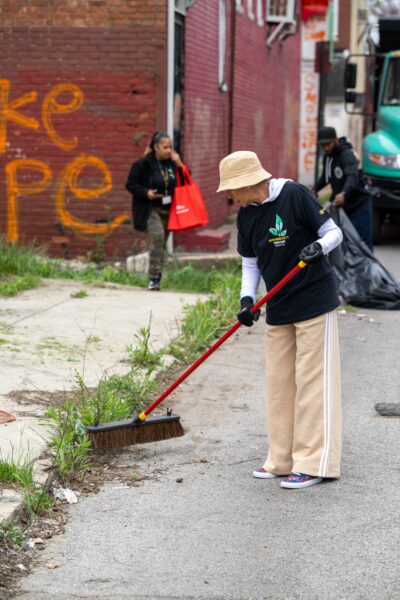The nonprofit world is increasingly filled with talk of mergers. And in Baltimore, February brought real-world action, as two local nonprofits developing youth for leadership formally combined in a move to broaden their impact.
Effective Feb. 15, Community Law in Action (CLIA) and The Intersection have merged operations. The move brought together two orgs with similar programming geared toward leadership training and grassroots advocacy: CLIA, founded in 1998, counts among its programming an initiative to train young people ages 15 to 18 as community advocates, engaging state legislators around key issues. The Intersection, founded in 2011, teaches high school students about civic action, and offers training to become community organizers.
They partnered over two years, and eventually found common ground. It’s a move toward “deepening the impact and increasing our capacity to be able to serve more families and more young people,” said CLIA’s executive director, Ryan Turner, who will lead the newly merged entity under CLIA’s banner.
With the merger complete, members of The Intersection’s board of directors joined CLIA’s board. On the staff, a program manager at The Intersection joined CLIA’s three full-time team members.
“Under the exceptional leadership of Ryan Turner, I am confident that by combining forces these organizations will set a new standard for partnership in Baltimore,” said City Councilman Zeke Cohen, who cofounded The Intersection while a teacher, in a statement announcing the deal. “As we think about healing our city from its enduring trauma, this merger models a difficult but critically important way of placing our children’s needs at the forefront.”
Turner said that when he met with former Intersection ED Randi Norris in the spring of 2020, he went into the conversation knowing that the two orgs had a history of partnering. He planned to propose the idea of merging. As it turned out, Norris entered the conversation with the same intention.
It meant confronting a wider reality about nonprofits: “There’s an oversaturation of nonprofits everywhere, but especially here in Baltimore, and it causes us to duplicate local work and efforts. One of the things that we talked about was, how do we connect so we can leverage dollars in a way that would help us to able to impact more young people?” he said.
Nationally, nonprofits are facing particular challenges in the wake of the COVID-19 pandemic and resulting economic downturn. The Johns Hopkins Center for Civil Society Studies reports that nonprofit jobs were down by 958,000 in January, when compared to February 2020. So there’s good reason for strategic conversations: “It’s important that our organizations remain and are sustainable so that we’re able were able to support the socioemotional health of young people,” Turner said.
In the specifics of this agreement, there are also lessons for the social impact sector as a whole to consider. So with an eye toward modeling that process, here’s a look at three things to keep in mind from the experience of the CLIA-Intersection merger:
Establish values
Once they were on the same page about the merger, Turner and Norris brought in their respective board chairs, who agreed it was a good idea. In turn, they developed a task force with members of each board. It ended up meeting every other week for seven months, speaking with stakeholders including youth participants, donors and volunteers. The first order of business: developing a working set of values for the combined organization.
“It sounds simple, but establishing values is very, very important,” Turner said.
That process allows for transparency and honesty, as well as being able to hear everyone out. They considered whether the merger made sense not just operationally, but programatically. It was also important to consider the “climate and culture” of each organization and what both organizations were bringing from their separate past into the future together, Turner said.

CLIA is training young people for leadership. (Courtesy photo)
Be patient
When they first met, the executive directors knew they had common ground, and thought highly of each other, but when it comes to a merger, there are big questions to consider: Which entity will continue and which will dissolve? And what do the finances really look like?
“The more we met, the more we understood that we were going to have to take a deep dive and be very patient and be very analytical,” Turner said.
It led a process that Turner thought might take two months to instead take seven. Turner likens the process to dating: There’s shared admiration, but coming together can force uncomfortable moments. So continued communication and a willingness to confront the most challenging questions helped to move forward.
Engage outside experts
The leaders were also upfront about the fact that neither had gone through a merger before, so they turned to experts who could assist. Paddy Morton, general counsel for Maryland Nonprofits, provided legal guidance. And they sought insight from John Brothers, the president of the T. Rowe Price Foundation, who is a local voice for nonprofits working together.
“It is truly inspiring to see two important community institutions coming together on behalf of our young people in this way, especially after the difficult 2020 that our local nonprofit sector had,” Brothers said in a statement. “I am hopeful that this will continue to bring other organizations together that can do more collectively than they can separately.”
And it didn’t stop with the merger: Going forward, the organizations will continue to work with Maryland Nonprofits on a six-month strategic planning process to continue developing a shared future.
Join the conversation!
Find news, events, jobs and people who share your interests on Technical.ly's open community Slack

Baltimore daily roundup: Film fest spotlights cinema's immersive frontier; over $1M for a wellness startup; $2B to rebuild the Key Bridge

Baltimore daily roundup: Key takeaways on the local tech ecosystem; a video editor's path to working with Keke Palmer; BCIT's new podcast

Baltimore daily roundup: 20 people building Baltimore's innovation community; a local startup's $15K win; the USMC's new tech office


